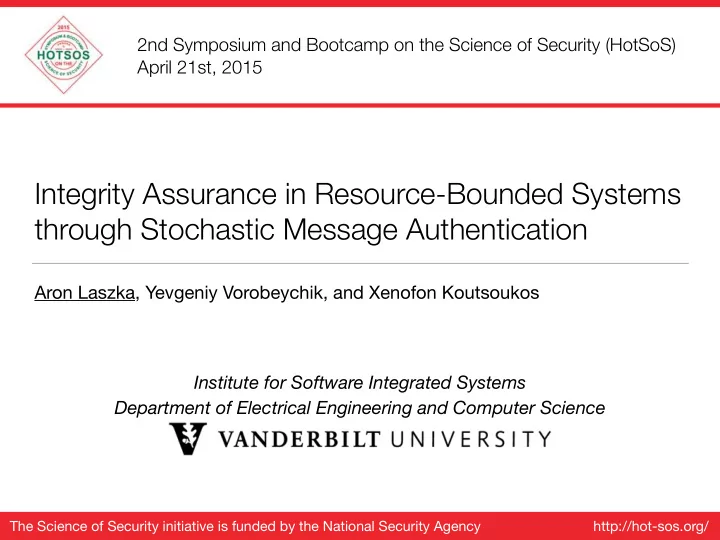

2nd Symposium and Bootcamp on the Science of Security (HotSoS) April 21st, 2015 Integrity Assurance in Resource-Bounded Systems through Stochastic Message Authentication Aron Laszka, Yevgeniy Vorobeychik, and Xenofon Koutsoukos Institute for Software Integrated Systems Department of Electrical Engineering and Computer Science The Science of Security initiative is funded by the National Security Agency http://hot-sos.org/
Data Integrity • Data integrity: assuring that data cannot be modified in an unauthorized and undetected manner • Classic, non-resource-bounded example: HTTPS desktop computer webserver Not really an issue these days, right?
Example of Data-Tampering Traffic monitoring: Sensys Networks VDS240 • wireless vehicle detection system based on magnetic sensors embedded in roadways • insecure communication protocol lacks integrity protection • attacker may cause disastrous traffic congestions
Message Authentication secret key cryptographic computation tag tag tag message m3554ge message message m3554ge cryptographic computation tag’ computationally expensive secret key
Limited Insufficient Sufficient amount of resources resources resources some messages are messages are not messages verified verified are verified maximal maximum zero security achievable security security
Stochastic Verification select randomly verify which messages tag1 to verify tag1 message1 message1 message1 ? message2 tag2 verify m3554ge2 tag2 m3554ge2
Applications • In many scenarios, suboptimal data acquisition and control is costly but not disastrous • ine ffi cient tra ffi c control • incorrect smart-metering • … • Resource-bounded devices • battery-powered devices • legacy devices • low-performance devices • … • Comparison to lightweight cryptography • we build on well-known and widely deployed cryptographic primitives • our system adapts to arbitrary resource bounds
Game-Theoretic Model “Which messages to verify?” Stackelberg security game with a defender and an attacker • Messages divided into classes • messages of class i may cause Li damage • 1. Defender chooses verification probabilities pi • subject to computational budget constraint • ∑ piTi ≤ B where Ti is the cost of verifying all messages of class i
Game-Theoretic Model (contd.) 1. Defender 2. Attacker selects the number ai of modified/forged messages for each class i • knows the defender’s strategy (i.e., pi for every i ) • 3. Payo ff s outcome: 1 - Π ( 1 - p i ) a i Π ( 1 - p i ) a i attack detected : attack not detected : attacker receives defender loses / punishment F attacker gains ∑ a i L i
“region of deterrence” Illustration of the Defender’s Payoff Defender’s p 2 payoff p 1 F = 0.5, L 1 = 1, L 2 =3
Deterrence Strategies • Deterrence strategy: attacker’s best response is not to modify any messages Theorem: The defender has a deterrence strategy if and only if and the minimal deterrence strategy is
Non-Deterrence Strategies Defender’s p 2* p 2 B payoff p 1 p 1* F = 0.5, L 1 = 1, L 2 =3
Continuous Relaxation • No closed-form solution for the original model • Continuous relaxation of the model ai is continuous (i.e., ai = 1.5 means that the attacker modifies one • and a half messages) Theorem: Optimal strategy in the continuous relaxation is
Numerical Example Comparing Strategies Defender’s loss Computational budget B F = 0.5, L 1 = 1, L 2 = 2, L 3 = 3, T 1 = T 2 = T 3 = 1
Numerical Example Comparing Strategies Defender’s loss Computational budget B F = 0.5, L 1 = 1, L 2 = 2, L 3 = 3, T 1 = T 2 = T 3 = 1
Experiments • Implementation and testing on an ATmega328P microcontroller • Message authentication tag generation and verification: • HMAC (keyed-hash message authentication code) • using the SHA-1 hash function • Random number generation: • linear-feedback shift register
Experimental Results Running time per message [ms] Probabilities ∑ pi
Resource-Bounded Senders • So far, we have saved computation only at the receiver • Two-way communication up to 100% saving sender receiver when receiving + 0% saving when sending up to 50% saving receiver sender overall “Could we also save computation when generating tags?” next: stochastic authentication tag generation •
Stochastic Message Authentication send a random subset detect modifications of the messages with to messages with correct tags correct tags tag message1 message1 m3554ge1 message1 message2 message2 m3554ge2 fake tag … … message2 ? • Fake tags • indistinguishable from correct tags for the attacker • distinguishable from incorrect tags for the receiver • computationally inexpensive to generate and verify
Generating and Verifying Fake Tags Proof-of-concept algorithms based on the HMAC construction • with a Merkle-Damgard hash function Implementation and testing show substantial savings for both • the receiver and sender on an ATmega328P microcontroller
Conclusion • Stochastic message verification • message authentication for resource-bounded devices • game-theoretic model for defending against worst-case attackers • experimental results confirm computational cost model • Next: stochastic message authentication tag generation • allows saving computation for both sender and receiver
Thank you for your attention! Questions?
Recommend
More recommend